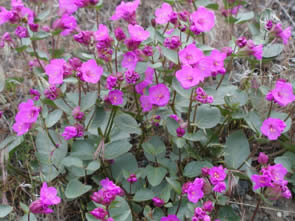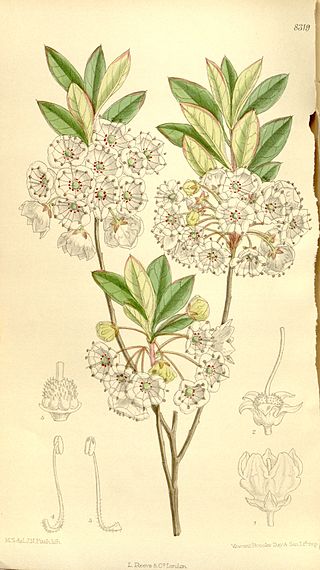
Kalmia is a genus of about ten species of evergreen shrubs from 0.2–5 m tall, in the family Ericaceae. They are native to North America and Cuba. They grow in acidic soils, with different species in wet acid bog habitats and dry, sandy soils.

Mitchella repens is the best known plant in the genus Mitchella. It is a creeping prostrate herbaceous woody shrub occurring in North America belonging to the madder family (Rubiaceae).

Dicentra cucullaria, Dutchman's britches, or Dutchman's breeches, is a perennial herbaceous plant, native to rich woods of eastern North America, with a disjunct population in the Columbia Basin.

Kalmiopsis leachiana, commonly referred to as Siskiyou kalmiopsis, is a rare flowering plant endemic to the Siskiyou Mountains of southwest Oregon, where it is specially protected in the 179,755-acre (727.4 km2) Kalmiopsis Wilderness reserve. It was discovered in 1930 by Lilla Leach in the Gold Basin area.

Rhododendron macrophyllum, the Pacific rhododendron, California rosebay, California rhododendron, coast rhododendron or big leaf rhododendron, is a large-leaved species of Rhododendron native to the Pacific Coast of North America. It is the state flower of Washington.

Kalmiopsis Wilderness is a wilderness area in the Klamath Mountains of southwestern Oregon, within the Rogue River – Siskiyou National Forest. It was designated wilderness by the United States Congress in 1964 and now comprises a total of 179,755 acres (72,744 ha). There are approximately 153 miles (246 km) of trails on 24 established hiking trails in the area.

Fritillaria gentneri, or Gentner's fritillary, is a rare species of flowering plant in the lily family Liliaceae, that is endemic to southwest Oregon and adjacent Siskiyou County, California, USA. Its habitat is dry, open woodlands and chaparral at 1,000–5,000 ft (300–1,520 m), where it blooms from March through July. However, most populations have generally finished blooming by the end of May. As with many plants, the lower elevations bloom earliest with the bloom period moving up following elevation.

Caltha leptosepala, the white marsh marigold, twinflowered marsh marigold, or broadleaved marsh marigold, is a perennial species of flowering plant in the buttercup family. It is native to western North America from Alaska to New Mexico, where it grows in wet mountain habitats in alpine and subalpine regions. There are two general wild types of this species, one native to the interior and one that grows along the Pacific coast and coastal mountains, but these are not always treated separately.

Lilium parryi, common name lemon lily, is a rare species of lily.

Rosa woodsii is a species of wild rose known by the common names Woods' rose, interior rose, common wild rose, mountain rose, pear-hip rose, and prairie rose.

Rumex venosus is a species of flowering plant in the knotweed family known by the common names veiny dock, winged dock, sand dock, and wild-begonia. While not of any particular agricultural use, its cousins rhubarb and buckwheat are. It is native to central and western North America, from southern parts of the Canadian prairies, through to Mexico.

Trautvetteria is a genus of flowering plants in the buttercup family. Today it is often considered a monotypic genus, containing only one species, Trautvetteria caroliniensis, which is known by the common names Carolina bugbane, false bugbane, and tassel-rue. A second species, T. japonica, is now generally considered a variety of this species. The genus is named for the botanist Ernst Rudolf von Trautvetter.

Rhododendron periclymenoides, the pink azalea or pinxter flower, is a species of shrub in the heath family Ericaceae. It is native to eastern North America, where it is widespread from Alabama to New Hampshire. It is often found in riparian areas, in wet to dry forests.
Prunus eremophila, also known by its common name Mojave Desert plum, is a rare species of plum native to California.

Clitoria fragrans is a rare species of flowering plant in the legume family known by the common name pigeon wings, or sweet-scented pigeon wings. It is endemic to Central Florida, where it was known most recently from 62 occurrences, but no current estimates of the total global population are available. The plant is a federally listed threatened species of the United States.

Mirabilis macfarlanei is a rare species of flowering plant in the four o'clock family known by the common name MacFarlane's four o'clock. It is native to Idaho and Oregon in the United States, where it is only known from three river canyons. It faces a number of threats and is federally listed as a threatened species of the United States.

Chrysolepis chrysophylla is a species of flowering shrub or tree in the beech family known by the common names golden chinquapin, giant chinquapin, and western chinquapin. It is native to the Pacific coast of the United States.

Kalmia cuneata is a species of flowering plant in the heath family known by the common name whitewicky, sometimes spelled white-wicky or white wicky. It is native to the eastern United States, where it occurs only in North Carolina and South Carolina.

Rhododendron austrinum is a species of flowering plant in the heath family known by the common names Florida flame azalea, honeysuckle azalea, Southern yellow azalea, and orange azalea. It is native to the southern United States, where it can be found in Alabama, Florida, Georgia, and Mississippi. It is also a common ornamental plant.

North American azaleas are flowering shrubs in the genus Rhododendron, section Pentanthera, subsection Pentanthera, so named because they all have five stamens. Most are in the United States, with one species found in Canada and one being found in Mexico. North American azaleas are commonly confused with azaleas of Asian origin, the evergreen azaleas. North American azaleas are deciduous and produce two types of buds. One is a larger and produces about 20 flowers while the other bud produces a leafy shoot. The flower color, fragrance, and number of stamens vary among species.



















